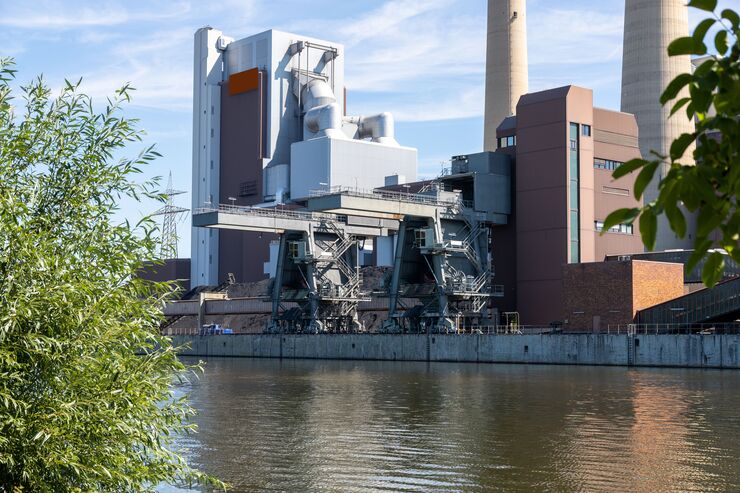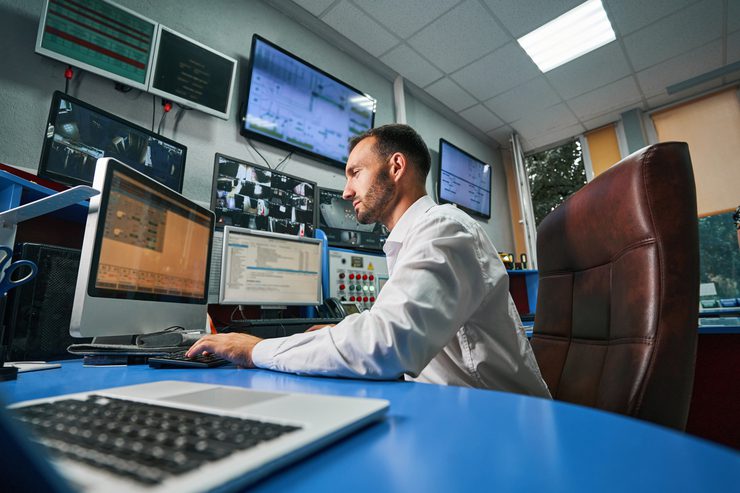Digital Twins Provide the Platform to Identify Potential Problems and Improve Power Plant Performance
Technology has become vital to reliable and efficient power plant operations, and few technological tools are more beneficial than digital twins. Some experts even believe we’re on the verge of a digital twin boom, with the market predicted to grow tenfold in the next four years.
What exactly is a digital twin? That’s a question that often gets a different answer depending on who you ask. IBM, for example, calls a digital twin “a virtual model designed to accurately reflect a physical object.” For it to work, the object being studied is outfitted with various sensors related to vital areas of functionality. The sensors produce data about different aspects of the physical object’s performance. The data is then relayed to a processing system and applied to the digital copy. “Once informed with such data, the virtual model can be used to run simulations, study performance issues, and generate possible improvements, all with the goal of generating valuable insights—which can then be applied back to the original physical object,” IBM explains.
The definition can change a bit depending on the use case for the digital twin. Rick Kephart, vice president of Technology with Emerson Power and Water Solutions, offered a description more specific to power plant operations (Figure 1). “A digital twin is a virtual, real-time replica of the combined control, plant and process systems implemented at the level of detail and fidelity necessary to accomplish a desired task. Digital twins provide a realistic, safe, and risk-free environment for users in different roles—such as operations, engineering, performance monitoring, and maintenance—to interact with a variety of operating scenarios without disrupting the live process,” said Kephart.

Evolving Technology with Expanding Capabilities
A spokesperson from the Enterprise Software Solutions organization with Hitachi Energy, explained how he’s seen digital twins evolve over time. He said early-stage digital twins were basically just “a digital representation that had some operational data associated with them.” They effectively gave users an operational view of specific assets at a given point in time. “And that was interesting,” he said. However, digital twins have since evolved to include condition assessment and condition health tools, among other things. He said today’s digital twins are effectively “a 3D rendering,” or “a virtual reality view of the asset.”
Hitachi Energy offered a power grid–related example, where digital twins can be very complex and sometimes include multiple large substations and high-voltage direct-current (HVDC) conversion equipment and ties. Their spokesperson noted that digital twins incorporate “a lot of sensor data,” which allows operators to monitor the actual performance of specific assets and the health of key components. More importantly, however, the digital twins include “enterprise software,” which allows all of the assets in the system to be evaluated holistically. That’s important “because no one operates a singular asset,” he explained. Rather, users must understand how “a series of connected assets” are performing.
Abhishek Pednekar, senior product manager with Honeywell Connected Enterprise, said digital twins mainly consist of three basic elements: contextualized data, simulation/calculation, and a visualization layer. He explained they come in two main functional categories: design digital twins and operations digital twins. While design twins are mainly used for design and engineering purposes, operations twins are regularly used for training workers, monitoring performance, soft sensing, optimization, and past-present-future scenario analysis in a virtual environment.
“In addition, there are also process digital twins, which consider the whole process and interaction of one piece of equipment with another, often supplementing actual measured data with digital twin derived data and insights, and asset digital twins that focus on in-depth asset performance for key pieces of equipment,” Pednekar told POWER. “The end goal for digital twins is to improve profitability and reduce downtime,” he said.
The Nuts and Bolts Behind Digital Twins
Kephart laid out some of the key components of Emerson’s digital twin solution. These include:
- Mathematical models that accurately capture the dynamic operation and interactions of plant equipment and processes.
- Virtual controllers, which are exact replicates of the plant controllers, that execute the actual plant controls and the mathematical models.
- An instructor station that controls the simulation for operator training.
- Standard control system software for operations and engineering functions.
- A replica of the control system applications (such as logic, graphics, configurations, and more).
“Unique to Emerson’s Ovation digital twin is our simulator uses the same Ovation automation platform software and technologies as the plant control system,” Kephart explained. “Engineering and maintenance of simulator controls and graphics can be performed by any staff member familiar with standard Ovation system tools. Users training or testing logic using the Ovation digital twin work in an environment that replicates the same interfaces they will see in the control room in the real world.”
Meanwhile, Pednekar said the key components in Honeywell’s system are design information for equipment like compressors and turbines, instrumentation data sheets, and process flow representation either in terms of a simulation or calculation, which is usually obtained from piping and instrumentation diagrams (P&IDs), isometric drawings, and the like. In addition, real-time data and historical data—both process and lab information—is required. The process and lab data are typically obtained from plant historians and lab information systems.
“Rigorous data-cleansing algorithms are required to ensure high-quality data to the digital twin. Analytics can be incorporated to improve speed of execution and accuracy of the digital twins,” Pednekar said, while noting that digital twins are typically deployed on cloud for scalability and improved usability, but can also be deployed on premises.
Demand for Digital Twins Is Growing
According to a recent report issued by MarketsandMarkets, an intelligence and market research platform, the global digital twin market size in 2023 was about $10.1 billion in revenue. Remarkably, MarketsandMarkets expects the digital twin market to grow to $110.1 billion in 2028, a compounded annual growth rate of 61.3%. Notably, North America is expected to account for the largest share of the growth, owing to the high adoption rate of advanced technology on the continent. The firm’s researchers said upgrades to infrastructure and a skilled workforce also contribute to high implementation rates for digital twins in the U.S. and Canada.
Another huge driver behind the growth in digital twins is a strong belief in the value of predictive maintenance (Figure 2). “The utilization of digital twins for predictive maintenance is widespread,” the MarketsandMarkets report says. “Apart from predicting failures, this technology offers several advantages that optimize maintenance. Digital twins enable the calculation of maintenance-related key performance indicators and forecast how machines perform under different conditions. By serving as accurate real-time models of a product, process, or system’s condition and performance, digital twins facilitate simulations and predictions of behavior under specific factors such as runtime, exposure to extreme operating conditions, and temperature.”

Hitachi Energy’s spokesperson agreed that the predictive aspects of digital twins are important. “It can start as a one-line diagram—a physical view of your network—then zoom down into specific assets, where you have 3D models and you can see which components are in early stages of failure. You can see what the impact of failure is and what the time to failure is, so you’re able to make operational decisions, whether it’s a switching operation, deploying a crew, or scheduling an outage, whatever that looks like,” he said.
He continued: “That’s where we see the digital twins going—from sort of a nice engineering academic viewpoint of a discrete asset to now a collection of assets, the collection of digital twins in my system and entire process. What does that look like and how is that affecting performance based on current or even projected load?”
Understanding the Benefits of Digital Twins
One of the biggest challenges facing digital twin suppliers is raising awareness regarding cost benefits offered by digital twins. The MarketsandMarkets report says, “Due to the novelty of the technology and the substantial changes it entails, end users are still determining the economic benefits, investment requirements, and future cost savings. Assessing the potential of a digital twin is considered complex and multifaceted, further impeding its widespread adoption.”
However, Kephart suggested the value of digital twins is quantifiable. “Cost savings can be realized by reducing startup or shutdown times and minimizing the operational errors that lead to process upsets, equipment damage, or forced outages. Because Emerson’s Ovation digital twin replicates the Ovation plant control system, additional cost savings can be realized through less maintenance, training, and service required to maintain one platform for the digital twin and plant controls versus multiple. Users can save engineering time and associated costs by performing ‘dry run’ control system upgrades, and developing and validating procedures that reflect changes made during critical operating periods,” he explained.
Kephart also provided some real-world examples of cost savings captured through the use of digital twins. “We have several examples of the value created using Emerson’s Ovation digital twin. Platte River Power Authority [PRPA] reduced plant simulated startup and shutdown time by 44%, enhanced operator efficiency, and boosted plant performance. Southwestern Electric Power Co. significantly streamlined operator training, and reduced the time and expense associated with commissioning a greenfield power plant. Consolidated Edison optimized their investment in new plant technology by dramatically reducing the startup time of a greenfield power plant,” he said.
“A more recent example that is still in development is the collaboration between Emerson and Mitsubishi Power Americas to build and deploy the next generation of simulation with advanced analytics for plants operating with the latest Mitsubishi gas or steam turbines. Intermountain Power’s IPP Renewed project will use the Ovation digital twin solution to optimize performance and reliability, automate operational decision-making, and support commissioning and training,” Kephart added.
A video highlighting the benefits of the PRPA digital twin implementation noted that the Rawhide Energy Station, which includes a 280-MW coal-fired unit among other generation assets, completed more than 400 man-hours of training within just four months using its Ovation digital twin, which led to the startup and shutdown time savings, and associated fuel savings, which were significant. Still, other benefits were also captured.
“I use it more for testing of patch releases, testing of new control designs that we want to implement, or if we want to do any tuning changes on our system,” Johel Comas, senior electrical controls engineer with PRPA, said in the video. “If we want to do a change on the primary air flow, we would test it here on the simulator first,” he explained, noting that he was skeptical at first, but quickly became a believer in the solution.
“I did it here. I liked the result. And, then, I did it on the main unit, and it mimicked exactly what we wanted to do,” Comas said. “That was when I was really, really sold on the product.” As further explained in the video, the ability for the Ovation digital twin to run virtually parallel with the control system gives operators the opportunity to preemptively experience what may happen in their plant, so they can plan for it before it actually occurs.
“As the plant manager, it gave me a real handle on risk management, so that my engineers and technicians were free to come up with unique ideas to tweak or upgrade the control scheme, and I didn’t have to worry about: ‘What’s that going to do to the plant? Are we going to have an upset? Am I going to trip the unit because I’ve done something?’ They could actually load it into the simulator and see what would happen beforehand. I could see what they did and it gave me complete confidence that we were really mitigating risk before we actually made a live change to the unit,” said Andy Cofas, plant manager at the Rawhide facility when the station deployed its digital twin. “That was a big plus that I didn’t know we could do when we went through this process, but now that we’ve been through that, man, I wouldn’t give that up for the world.”
Honeywell’s Pednekar suggested there is great value in the problem-solving capabilities of digital twins. Specifically, he noted four key benefits:
- Enhanced Troubleshooting. Digital twins can help with root cause analysis (RCA) investigations and can provide granular process insights. This reduces unintended downtimes and conservative operations, validates issues, and supports the development of mitigation strategies.
- Expanded Soft-Sensing Capabilities. Digital twins can help overcome issues with unreliable or inadequate instrumentation.
- Improved Scenario Analysis and Optimization. Digital twins give users the ability to perform past, present, and future analysis on a plant, which allows faster operational changes to be implemented.
- Better Plant Performance. Digital twins help optimize operations to meet a gross objective function, utility consumption minimization function, or other desired objectives.
Technology Continues to Advance
Yet, even as valuable as digital twins are today, they continue to be improved. “Advancements in artificial intelligence (AI) and machine learning (ML) algorithms enhance the accuracy and effectiveness of predictive maintenance with digital twins. These technologies enable the detection of patterns and anomalies in data, identifying early warning signs of equipment degradation or failure. As AI and ML capabilities continue to improve, the predictive maintenance capabilities of digital twins are expected to become even more precise and reliable,” the MarketsandMarkets report says.
Kephart said the use of AI is one of the biggest trends he’s seen in the power industry. “There is a growing focus on using artificial intelligence to improve efficiency and productivity via an AI-assisted workforce,” he said. “Integrating digital twin technology with AI models can help developers determine the data needed for continuous learning of what constitutes ‘normal’ operations in varying conditions and identify ‘off-normal’ conditions. Based on the wealth of knowledge AI systems will gain from digital twin training and forecasting, they will be able to work side-by-side with operators of any experience level to help diagnose problems and suggest or implement the control actions necessary to get processes back on track—or at least maintain safe operating conditions.”
AI is also beginning to be used to help operators identify what plant information is truly important. “Control room operators are really suffering from alert fatigue,” Hitachi Energy’s spokesperson explained. “How do you take those alarms that are just happening because of typical setpoints, using AI and other tools—whether it’s a machine learning model or different forms of AI—to say: ‘This requires human intervention. This is something that we need to take an action on today,’ ” he asked.
“It becomes less about ‘here’s an alarm—here’s the information’ that people then have to think about and digest and figure out what they need to do. Rather, ‘here’s an action you need to take, and here’s the time at which you need to take the action,’ ” Hitachi Energy said. “That, I think, is where the digital twins are having the most value.”
Digital twins offer another benefit through the ability to consolidate control rooms (Figure 3). “As power generation portfolios are changing, so is the way power plants within those fleets are being controlled and monitored,” said Kephart. “Consolidation of multiple plant operations into a single, centralized remote operations center is helping to improve reliability, reduce costs, and increase operational flexibility. Digital twins can help cross-train co-located experts to remotely monitor and operate a variety of assets. Maintenance and diagnostic personnel within the remote operations center can also use the digital twin to simulate a malfunction, analyze the results, and recommend a new operating strategy.”

Finally, modeling plant or system operation with a digital twin and understanding what condition-based maintenance is required to reliably get from one year or outage to the next is a remarkable advancement that is on the horizon. Hitachi Energy suggested very soon companies will no longer need to do maintenance simply because it’s on the schedule in a work order system, for example, because the work hasn’t been done in some period of time, such as five years. Instead, with predictions about how a plant or distribution system will be used over an upcoming operational period, digital twins will be able to simulate the load behavior under expected weather conditions, and determine the consequences on equipment health, reliability, and availability. With time-to-failure of all the components identified, the maintenance scope can be precisely defined, allowing teams to focus on equipment that presents the most risk while avoiding unnecessary work, saving time and money.
“I don’t think there’s a full set of products yet that can do the complete simulation the way that customers need, but that’s where I think we’re headed,” said Hitachi Energy’s spokesperson. “I think there’s a big market there, and I think it’s going to become very necessary, especially on the distribution side.”
It’s certainly an exciting time, and one in which change is happening quickly and constantly. Power companies will clearly do well to take advantage of all the benefits digital twins can provide.
—Aaron Larson is POWER’s executive editor.